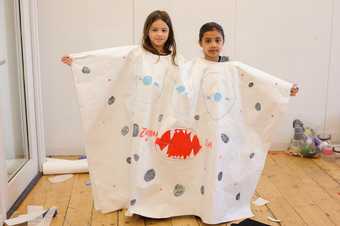
Workshops with Columbia Road Primary School, Year 3, Whitechapel Gallery, 2015
Richard Eaton
A few years ago on a visit to the Freud Museum in London, I encounter Louise Bourgeois’ recently discovered archive of writings relating to her years undergoing psychoanalysis. Her confessional and brutally honest tone triggered what I would describe as an experience of ‘deep reading’. I find myself scrutinising each handwritten sentence listed on numerous pieces of paper of different size. I start taking notes, as if the time of looking into someone else’s secrets would be limited. Immersed in the artist’s anxieties and exposed to the reverberations they begin to produce in my mind, my attention turned to one single obsession: list making. In a woven piece of fabric with hand-embroidered letters, I read:
I am afraid of silence
I am afraid of the dark
I am afraid to fall down
I am afraid of insomnia
I am afraid of emptiness
The Name of Fear is a new work by the Brazilian artist Rivane Neuenschwander (b. 1967, Belo Horizonte) realised as part of the Whitechapel Gallery Children’s Commission. 1 My visit to the Freud Museum relates in a non-linear way to one of the early stages of working with the artist. Her project started with the act of list making and by collecting and listing childhood fears.
The Name of Fear reflects Neuenschwander’s research and long term interest in psychoanalysis, especially the lines of convergence that might be drawn between the psychoanalytical process and her own practice and creative work. As the title suggests, the project poses the question of ‘fear’, and considers how fear can be translated and formalised through language, drawing and objects. To interrogate childhood fears is also to confront the ways in which they shape us as adults. How do we narrate and inhabit our own fears?
Rather than an artwork made for children – which would assume a prescribed outcome and a pre-determined audience, the Children’s Commission speculatively considers the new and intuitive relationships that children bring to the world of objects mainly through play 2 and their engagement with situations ‘where things are being visibly worked on’. 3 This is what lies at the heart of the working process in the lead up to The Name of Fear: to enable a collaboration that unfolds in close dialogue with the artist, providing a platform for creative experimentation that triggers new developments within her own art practice. The idea or methodology it explores is precisely that of something being ‘worked on’ – a productive space for artists, art institutions, participants and spectators alike that might evolve as the ‘construction site’ recalled by Walter Benjamin when discussing a child’s play. 4 A space that activates our sensory imagination, our curiosity and the desire for multiple explorations of what art might be in a particular place and time.
Rivane Neuenschwander’s work is made of discrete gestures and displacements. As pointed out by the psychoanalyst Suely Rolnik, ‘it reactivates the ludic, the affective and the poetic in everyday gestures and in the territories they produce’. 5 Collaboration, exchange and friendship are central to the artist’s work, often in a self-effacing gesture that interrogates authorship and places an emphasis on the shared experience as much as in its formalisation.
From sculpture, installation and film to drawing and embroidery, the materials used in previous works: soap, chalk, eggshells, foam, fruits, sand, seashells, powder and water - point to the transient nature of experience and the blurred line between presence and absence, permanence and impermanence, concept and material. There is also a recurrent interest in the matter of words, in speech acts and communication through language, its misunderstandings and traces, an open-ended and expansive journey that is activated by an encounter and embodied by those who are affected by it.
To recall the experiences that have shaped the current work, four very distinct projects should be mentioned in a non-chronological way: The Quiet in the Land (2000), First Love (2005), The Fever, the Sewing Box and the Ghost (2015) and I Wish your Wish (2003).
In her early participatory project titled The Quiet in the Land (2000), Rivane Neuenschwander worked with a group of vulnerable teenage girls, with Projeto Axé and the Museum of Modern Art in Salvador, Bahia. For over a month, they came together on a daily basis to discuss their dreams and wishes. Using bed sheets as material with its associations to ‘homeliness’, comfort and intimacy, as opposed to a traumatic childhood spent sleeping on the streets, the process began with the symbolic exchange of old bed sheets for new ones. Names and dreams were embroidered in the new blank sheets. Names were also carved on cocoa soap bars as self-portraits turned into ephemeral compositions. A ritualistic washing of the old bed sheets happened by the seaside (in salt water), leading to a colourful installation of fading patterns drawn from the cathartic gesture of washing away. ‘Quarar’ refers to the act of drying laundry in the sunlight in order to make it cleaner and clearer. Poetically and formally the installation created with the group echoed a geometry of affect and hope as reflected through shared memories and experiences. With its richness and complexity, Neuenschwander recalls how this project awakened a profound interrogation of the artist’s contribution and role within a community, its ethical stances and endless possibilities and how the subjective emerges in the collective.
First Love (2005) is a participatory performance that results in a series of drawings made by police sketch artists who are hired for that purpose each time the piece is presented. The audience is invited to book a session and to describe their first love. Using techniques developed by the police to help people remember a physiognomy, the police sketch artist listens and helps translating memory into words. From this process, a drawing emerges as an interpretation of what has been said and heard. According to Neuenschwander, ‘it is important that a police sketch artist makes the drawing because of the traumatic aspect. You tend to think of a first love as something nice, but you don’t know’. In a recent conversation between the artist and the psychoanalyst Anoushka Grose6 the latter pointed to the relation between the spoken word and the drawing as one that ‘heightens the visibility of misunderstanding and interpretation’, and that gives ‘visible form to the difference’. 7 Can a parallel be made here between the psychoanalyst and the detective? Similarly, they gather pieces of information that are rather fragmentary and obscure, focusing in recalling what seems banal, acknowledging the impossibility of naming trauma, of giving it a shape.
For The Fever, the Sewing Box and the Ghost (2015), Neueunschwander translated into visual form the childhood memories of her closest friends – working across sculpture, drawing, embroidery, photography and film. She began by collecting their memories through letters, photographs, conversations, drawings and recordings. One of the stories she tells that I found most compelling is that of a friend who lived next to a factory in Recife (Brazil), who described growing up in agony each time he heard the factory siren, as it signalled the end of playtime and the return to school. According to the artist, years later he realised that his agony was the relief of the factory’s workers, and was then able to shift the meaning of his own trauma. The other story is that of a friend whose mother wouldn’t allow drawing on the wall, so she began to make drawings underneath tables or inside drawers, always in search of hidden places. Neuenschwander was surprised with how peculiar and estranged each memory could be in relation to her own, although maintaining a degree of familiarity - as if this collection of childhood memories could become an abstracted portrait of a certain generation in Brazil, a coming together of all singularities that could define both individual and collective identity at a given moment in time.
In a similar impulse to collect, I Wish your Wish is made of hundreds of coloured textile ribbons with printed wishes of various people assembled by the artist for over a decade. Having grown up with these ribbons around my wrist, I was familiar with the tradition related to the church of Nosso Senhor do Bonfim in São Salvador da Bahia, one that surpasses the specifics of its geography. According to this tradition a wish is made as each knot of the ribbon is tied around the wrist - in the belief that the wishes come true when the ribbons tear apart and fall off. Around sixty new wishes are printed each time the piece is presented. 8 Each ribbon is hung from a hole and visitors are welcome to take one ribbon in exchange for a wish. Some wishes are very specific, such as ‘I wish for my own bedroom’, whereas others relate more widely to the history and culture of a place. For example when the piece was shown in Spain, during the peak of the economic crisis, most wishes were political, such as ‘I want financial security’, ‘I wish for capitalism to end’. This is a work that constantly feeds itself and disseminates. The wishes travel and can be spread across geographies. The all-enveloping surface of ribbons with exhilarating colours and textures renders visible a sense of hope and catharsis that is interlaced with the desire to imagine other possible worlds.
Words, drawings, objects
The Name of Fear evolved over a year, in three key phases that included workshops with local schools; a collaboration with a fashion designer; and an exhibition at the Whitechapel Gallery conceived alongside a series of public events for schools, families and the broader public.
In the first stage of the project, Neuenschwander worked with children aged seven to nine from four schools in London. The idea was to begin by collecting their fears. A series of workshops were led in collaboration with the artist Laura X Carle and the Whitechapel team; the artist introduced her work to the children, explained the aim of the project and talked about her own childhood fears.
A selection of images was presented to the children to prompt discussion on how fear is played out in different situations. In our ongoing conversations while shaping the project, several artists and works such as Hélio Oiticica’s Parangolés, Lygia Clark’s Relational Objects, Artur Bispo do Rosário’s Manto, or Lygia Pape’s Divisor, among many others, were spontaneously discussed and shared as integral to the working process. Neuenschwander’s elective affinities extended far beyond art history to include references from film and children’s literature, such as Jacques Demy’s Donkey Skin featuring Catherine Deneuve disguised as a donkey to hide from her father (adapted from a fairy tale by Charles Perrault) or the story of Little Red Riding Hood (also by Perrault). Among our source materials also featured images from folk traditions (the Mexican woven palm capes or the Katchina dolls made by Native American communities), to animals in nature (beetles and bees) and the more familiar superhero capes, with their supernatural and empowering associations.
After listing and discussing their fears, the children made drawings of ‘protective’ capes. But what led to the choice of this specific object? Why make capes? ‘I could not separate the fear from the idea of protection, especially when dealing with children, as a child with no fear is inevitably more exposed to danger’, points Neuenchwander. On the other hand, she notes, ‘fear shouldn’t take a paralysing proportion, so we need a certain protection or understanding to be able to deal with it’. 9
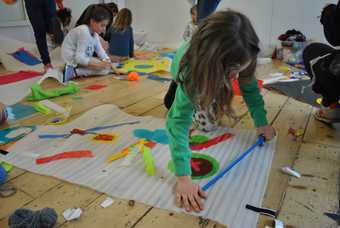
Workshops with William Tyndale Primary School, Year 3, Whitechapel Gallery 2015
Photo Whitechapel Gallery
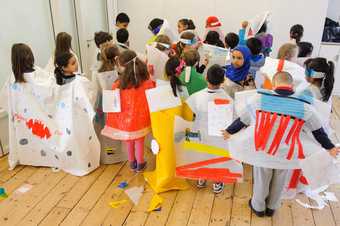
Workshops with Columbia Road Primary School, Year 3, Whitechapel Gallery 2015
Richard Eaton
Subsequently, the children’s initial sketches were transformed into individual designs for capes they could wear, selecting from a range of materials made available in the workshop space. In this embodied and performative act of making, the becoming-fear is made visible through strategies of resemblance, camouflage, shelter, or supernatural power. It also becomes apparent that one specific fear might hide a bigger fear, as some of the children’s comments would attest:
‘I am afraid of an airplane crash because I’m scared of heights. I am afraid of the first day of school because people might not play with me.I am afraid of drowning because if I sink to the bottom of the sea no one will see me.I am afraid of the end of the world because I might not experience all the things in life.I am afraid of thunders because they make loud noise when I’m sleeping’ 10
The second stage of the project evolved in collaboration with London-based Brazilian fashion designer Lucas Nascimento, alongside costume designer Gabriela Yaxis and seamstress Elizabete Lobo. Their expertise and dedication was central to the realisation of the artist’s idea and the team worked passionately in the production of the work. The artist’s house and studio became the ‘nest’ from which ideas took shape, where decisions were made amongst pieces of fabric, threads of all colours, sewing machines, clothing racks, hangers, alongside the children’s capes that had been piled on the floor (and to which the artist would return to examine details). The input of Neuenschwander’s two children (Hannah and Theo) should be acknowledged. They contributed with drawings, comments or serving as models to assess the first capes that were realised. This was truly a ‘child’s play’, combined with incredible skill, care and a labour-intensive process. Nascimento’s contribution was key to the translation of the children’s drawings into actual cape designs. The original drawings inspired the colours, the shapes and all the elements that identify each fear. The materials were also conceptually related to each cape and to the fear it represents. However, in this process of interpretation, some capes would combine two different fears such as spider/end of the world; bees/horror movies. The artist explains how this strategy is intended ‘to break the didactic dimension by adding a more interesting layer with the written word’. She then reiterates: ‘it is like translating poetry… it is very difficult but there is an element of freedom too’. 11 It is the children’s imaginative potential and freedom that emerge as defining features of the project.
Finally, as the exhibition was being installed, the Whitechapel Gallery invited the children for a special preview where they could wear the capes on display and ‘perform’ their fears. Their comments reveal the excitement of being part of the process:
‘When I was aged 3, I was scared of biscuits crumbs. One day I had a nightmare because I ate a biscuit and all the crumbs were on my bed. I thought that a monster would come to my bed and eat these crumbs and accidentally eat me as well. So my fear was connected to monsters! And I feel better and stronger now because of the idea of a cape that can protect me. I was so happy to recognise my cape in the exhibition…’
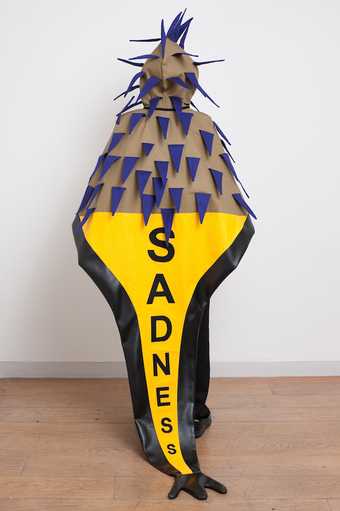
Workshops with Columbia Road Primary School, Year 3, Whitechapel Gallery 2015
Richard Eaton
‘The cape I designed had a shell on the back and protected me from spiders. I did not see any cape looking exactly like that today, but there was one I really liked - the one called ‘Sadness’. It was the most special and beautiful. The capes looked a bit different from what I expected. It was maybe because of the inputs of children from other schools. I thought it was very interesting to draw the capes first, to make ours, and then to see the ones the artist realised. I feel stronger now about myself and I feel I helped an artist to make something very special. Making the capes was the best part of this project. Being here made me forget about my fears and enjoy the artworks.’
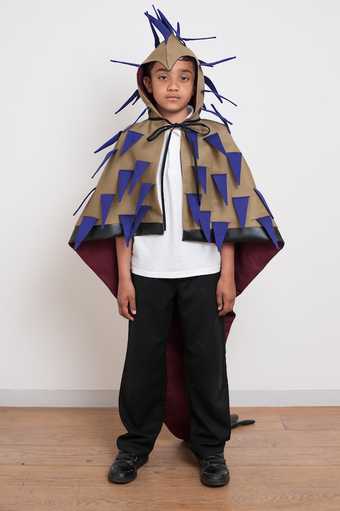
Workshops with Columbia Road Primary School, Year 3, Whitechapel Gallery 2015
Richard Eaton
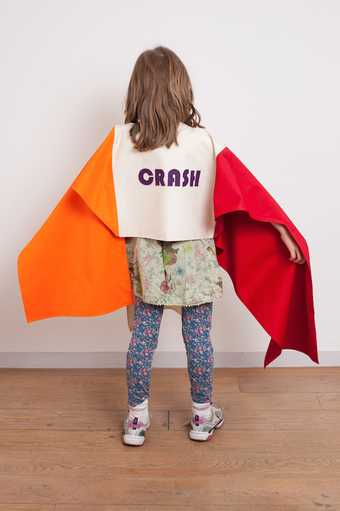
Workshops with Columbia Road Primary School, Year 3, Whitechapel Gallery 2015
Richard Eaton
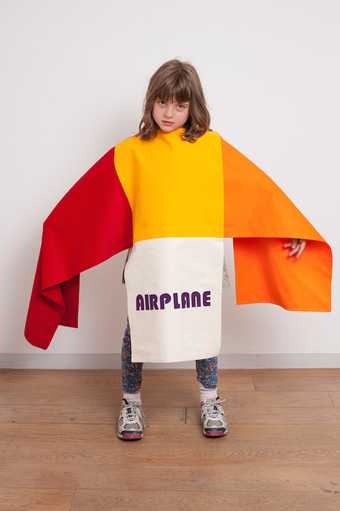
Workshops with Columbia Road Primary School, Year 3, Whitechapel Gallery 2015
Richard Eaton
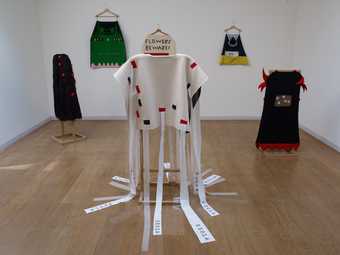
The Name of Fear, installation view Whitechapel Gallery 2015
Stephen White
Description. Translation. Expansion
A series of colourful handmade capes are displayed on clothing rails and valet hangers. Each cape is identified by its singular form, shape and choice of materials. Carefully crafted and made of cotton, felt, bubble wrap, plastic and silk, with stitched or embroidered details, they all carry different words: airplane crash, biscuit crumbs, clown, darkness, death, drowning, end of the world, fire, first day of school, ebola, flowers, ghosts, god, guns and knives, horror movies, nightmares, phoenix, sadness, scream, strangers, thunder, TV series. Sensorial, poetic and visceral, the display suggests a performative situation. Its visual, tactile and verbal associations trigger a process of self-identification. What do we fear the most?
The Name of Fear (2015) imagines how wishes might mirror our most intense fears, expanding on ideas that germinated over the years while gathering wishes for I Wish Your Wish. It addresses the relation between desire and fear as two sides of the same thing, as a two-way mirror: the latent content of the fear and what it conceals; what language and speech can and cannot reveal. In this process of ‘translation’ Neuenschwander considers the children’s subjectivities and her own and the relation between the individual and the collective. Moreover, she interweaves the personal and the social, the conscious and the unconscious, the affective and the repressed. As Freud tells us, fear is interwoven with the development of the unconscious. In his book The Interpretation of Dreams he points to the difference between dream-thoughts and dream-content, stating that:
‘the dream-thoughts and the dream-content present themselves as two descriptions of the same content in two different languages; or, to put it more clearly, the dream-content appears to us as a translation of the dream-thoughts into another mode of expression, whose symbols and laws of composition we must learn by comparing the origin with the translation’. 12 It is possible to establish here a parallel with fear – similarly to the dream, the fear-content that is articulated through language and speech can be discussed in relation to the latent fear-content. In the attempt to trace the processes of ‘fear-formation’, its uncanny element emerges as ‘something that was long familiar to the psyche and was estranged from it only through being repressed’13
The public conversation between Rivane Neuenschwander and Anouschka Grose sparked new discussions. In one of our email exchanges I was led to re-read Franz Kafka’s letter to his father:
‘Dearest Father, you asked me recently why I claim to be afraid of you. I did not know, as usual, how to answer, partly for the very reason that I am afraid of you, partly because an explanation of my fear would require more details than I could even begin to make coherent in speech. And if I now try to answer in writing it will still be nowhere near complete, because even in writing my fear and its consequences raise a barrier between us and because the magnitude of material far exceeds my memory and my understanding. Franz Kafka’ 14
I had also been drawn to examine the relation between text and textile, following research around a recent exhibition of artist Richard Tuttle at the Whitechapel Gallery, titled The Weave of Textile Language 15 What could be said about the use of fabric in Neuenschwander’s work? What to make of the relation between ‘mind’ and ‘hand’, word and visual translation, abstraction and representation? The Quiet in the Land, described at the beginning of this text, used bed sheets as material; The Name of Fear uses different types of fabric, alluding to a constellation of personal memories that inevitably resembles a self-portrait.
It is worth describing the sensuous and seductive materiality of the capes. Its shapes, colours and textures elicit rhizomatic associations. Black, blue, green, grey, orange, pink, purple, red, yellow. Transparent, opaque, hard, soft, fluffy, metallic. Attractive or repulsive. If fear leads us to think of darkness, Rivane Neuenschwander’s work exposes our ambivalent relationship to colour and the fluid relation between colour and language. 16 It also asserts the excessive and the erotic, recalling Brazilian carnival where all boundaries and hierarchies dissolve. As Hélio Oiticica noted when talking about the Parangolé Capes for wearing at his 1969 Whitechapel Gallery experience-exhibition ‘the cape is not an object but a searching process.’ 17
From the initial sketches and bits of dispersed materials, the beauty of forms and colours is now reactivated by a utopian imaginary that weaves together ethics and aesthetics. The capes signal a movement not of denotation but of playful evocation, where meaning happens in the vibrational possibility of the encounter, simultaneously towards interiority and alterity 18
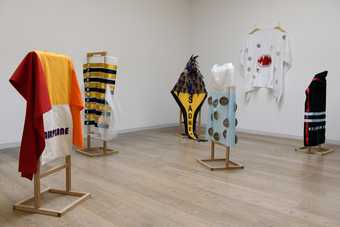
The Name of Fear, Installation View, Whitechapel Gallery 2015
Stephen White
When conceiving the exhibition together with the artist, a few questions re-emerged: How can an object show a process? How can this process live inside those who take part? What is at stake in this exchange with participants? The debate on participatory art practices and the so-called ‘turn’ to the social has for long now drawn attention to notions of singular and collective authorship. It is relevant to recall Claire Bishop’s argument about the tensions that persist between social and artistic discourses, its political positions and ethical stances and the role of the artist when engaging with the fabric of the everyday: ‘In using people as a medium, participatory art has always had a double ontological status: it is both an event in the world, and at once removed from it. As such, it has the capacity to communicate on two levels – to participants and to spectators – the paradoxes that are repressed in everyday discourse, and to elicit perverse, disturbing and pleasurable experiences that enlarge our capacity to imagine the world and our relations anew’. 19
Neuenschwander’s own words regarding the development of this commission shed light onto the process: ‘Whatever it results as an artwork it is important that the piece has autonomy and tells a story by itself. It needs to contain the experience but also to go beyond the museum and to leave the experience with the people that encountered it (…). In terms of the psychoanalytical process, there is a very specific time and space that you create with the psychoanalyst. Every time you go there and see the analyst you have an experience that is important, but you also know that when you are not there this experience continues beyond the walls of the consulting room. It has a long lasting effect. In some pieces I try to achieve that’. 20
The title of the work came last, as if it had always been there. The Name of Fear, borrowed from the song Araçá Azul by the Brazilian composer, singer and writer Caetano Veloso, echoes the writings of the leading modernist poet Carlos Drummond de Andrade - a powerful reminder that fear is both personal and political.
Fear [O Medo]
In truth we fear.
Born in darkness.
Postman, dictator, soldier.
Our destiny incomplete.
We were educated for fear.
We smell flowers of fear.
Wear the fabric of fear.
Of fear, red rivers
Wandering.
We are only men and nature has betrayed us.
There are trees, factories,
Escalating diseases, hunger.
We seek shelter in love,
This well known feeling,
And love lacked: it rained,
The wind was blowing, it was cold in Sao Paulo.
It was cold in Sao Paulo …
Snowed.
Fear, with its cape,
Disguises and embraces us.(…)21
Sofia Victorino is the Daskalopoulos Head of Education and Public Programmes at Whitechapel Gallery.
Tate Research Centre Working Papers, Autumn 2016 © Sofia Victorino
